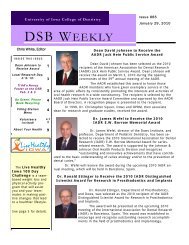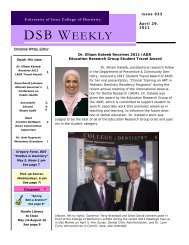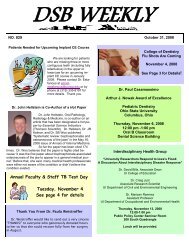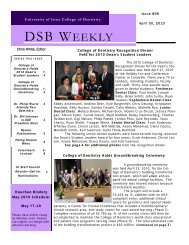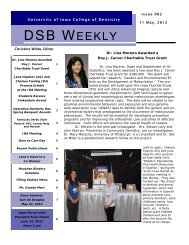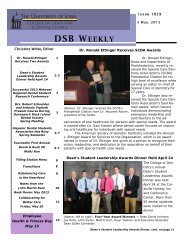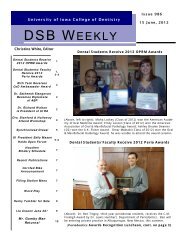Iowa Section of AADR - The University of Iowa College of Dentistry
Iowa Section of AADR - The University of Iowa College of Dentistry
Iowa Section of AADR - The University of Iowa College of Dentistry
You also want an ePaper? Increase the reach of your titles
YUMPU automatically turns print PDFs into web optimized ePapers that Google loves.
16. Assessment <strong>of</strong> Convenience <strong>of</strong> Glycyrrhiza uralensis Lollipops for Caries Prevention<br />
H.V. Guenther 1 , J.J. Warren 1 , D.R. Drake 1 , F. Qian 1<br />
1 <strong>University</strong> <strong>of</strong> <strong>Iowa</strong><br />
Objectives: Lollipops containing licorice root extract, Glycyrrhizol A, have been developed to reduce salivary levels<br />
<strong>of</strong> S. mutans, thus providing parents with another mode <strong>of</strong> caries prevention for their children. This pilot study<br />
sought to evaluate compliance and attitudes toward the “Lollipop Regimen.”<br />
Methods: 35 Head Start children were instructed to use lollipops twice per day for ten days (20 lollipops). Subjects<br />
were randomly assigned to either a control sugar-free lollipop group or to an herbal lollipop group (Dr. John’s<br />
Candies). Plaque samples were acquired from their teeth with a sterile cotton swab on Day 1 and Day 14, and were<br />
spiral-plated onto Mitis-Salivarius-Kanamycin-Bacitracin agar plates. On Day 14, parents were asked to complete a<br />
survey which assessed actual compliance, the children’s opinions on taste, and their attitudes on convenience <strong>of</strong> the<br />
“Lollipop Regimen” (scale <strong>of</strong> 1-5). Written responses elaborated reasons for these ratings.<br />
Results: 18 children (51%) completed the study. Of those, 5 consumed all 20 lollipops (28%), and 9 (50%)<br />
completed as many as 15 <strong>of</strong> 20. A slight majority (53%) who completed the survey rated the convenience as average<br />
or worse (score <strong>of</strong> 3 or less). Almost 75% <strong>of</strong> the children rated the taste highly, as either a 4 or 5. Compliance<br />
and ratings for both convenience and taste did not differ between the sugar-free or herbal group. <strong>The</strong>re were no<br />
differences in bacterial counts between groups at either Day 1 or Day 14.<br />
Conclusion: While children may approve <strong>of</strong> the taste <strong>of</strong> the herbal lollipops, actual compliance <strong>of</strong> the complete 10<br />
day “Lollipop Regimen” was low. Due to inconvenience, parents may not accept the herbal lollipops as an effective<br />
vehicle to use as a caries-preventive regimen. Further research, using larger samples sizes, should be conducted to<br />
further assess compliance and effectiveness <strong>of</strong> these lollipops.<br />
Supported by: NIDCR Training Grant, T32 DE014678-09<br />
17. Cephalometric Measurements in Mixed Dentitions with Class I Normal Occlusion<br />
J. Grabouski1 , J.J. Grabouski1 , R.N. Staley1 , C.M. Kummet1 1 <strong>University</strong> <strong>of</strong> <strong>Iowa</strong><br />
Objective: Using cephalometric (C) radiographs <strong>of</strong> mixed dentition (MD) subjects who had Class I normal<br />
occlusion in adolescence, (1) describe C norms for 8 year old children, (2) test hypothesis that C variables are<br />
similar in genders, and (3) test hypothesis that 8 and 12 year old C measurements taken by JJG are similar.<br />
Method: Longitudinal radiographs from 19 males (M) and 19 females (F) in the <strong>Iowa</strong> Growth Study [IRB<br />
permission] with Class I normal occlusion in permanent dentition (PD) were measured in MD at 8 years (Jessica)<br />
and 12 years in PD (Jeremy). C variables (11 angular, 3 linear) were measured with protractor and ruler. Intrarater<br />
reliability correlations (r = .9700-.9978, p< 0.0001) and inter-rater reliability correlations (r=.9548-.9986, p<<br />
0.0001) were acceptable. Student’s t-tests/Wilcoxon compared genders and ages. Histograms <strong>of</strong> MD variables<br />
were generated.<br />
Results: One variable, N-Me mm, differed between MD genders (M > F) (p=0.0152). Comparison <strong>of</strong> MD and<br />
p=0.0085), SNPog∞ (F: p=0.0000; M: p=0.0005), N-Me mm (F: p=0.0000; M: p=0.0000), MP : SN∞ (F: p=0.0053;<br />
M: p=0.0003), - : - ∞ (F: p=0.0052; M: p=0.0012), - : FH∞ (F: p=0.0221; M: p=0.0406), and - : NB mm (F: p=0.0023;<br />
M: p=0.0040). Other MD-PD differences were males, - : SN∞ (p=0.0080) and females, SNA∞ (p=0.0209), - : MP∞<br />
(p=0.0434), and - : APog mm (p=0.0098).<br />
Conclusions: <strong>The</strong> null hypothesis for differences between MD genders was accepted for all variables except N-Me<br />
mm. <strong>The</strong> null hypothesis for differences between MD and PD variables was rejected for 10 F variables and 8 M<br />
variables. Norms for age 8 are recommended.<br />
Supported by: <strong>University</strong> <strong>of</strong> <strong>Iowa</strong>, <strong>College</strong> <strong>of</strong> <strong>Dentistry</strong>, Dows Research Award<br />
19 18



